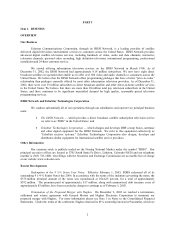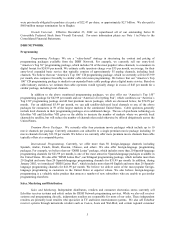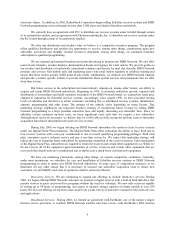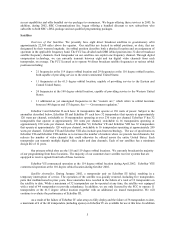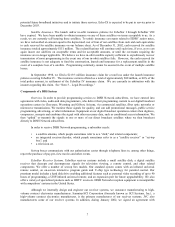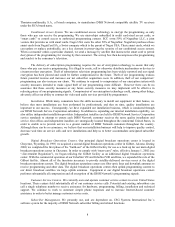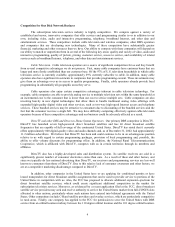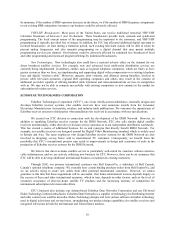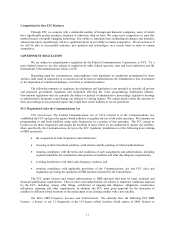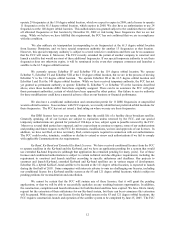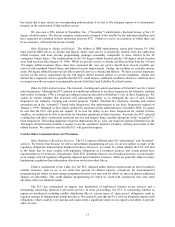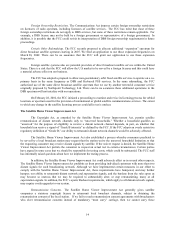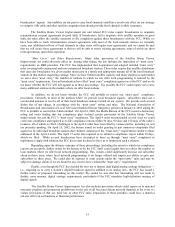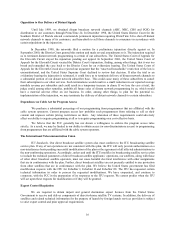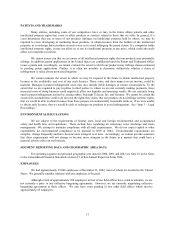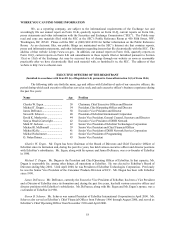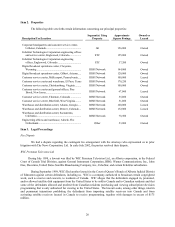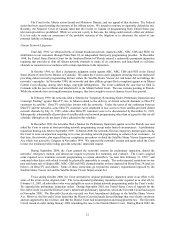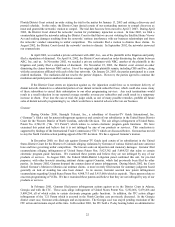Dish Network 2002 Annual Report Download - page 14
Download and view the complete annual report
Please find page 14 of the 2002 Dish Network annual report below. You can navigate through the pages in the report by either clicking on the pages listed below, or by using the keyword search tool below to find specific information within the annual report.12
operate 29 frequencies at the 110 degree orbital location, which we expect to expire in 2009; and a license to operate
11 frequencies at the 61.5 degree orbital location, which expires in 2008. We also have an authorization to use 24
frequencies at the 148 degree orbital location. This authorization was granted subject to the condition that we utilize
all allocated frequencies at that location by December 20, 2002 or risk losing those frequencies that we are not
using. While we believe we have fulfilled this requirement, the FCC has not confirmed that we are in compliance
with this condition.
We also sublease six transponders (corresponding to six frequencies) at the 61.5 degree orbital location
from licensee Dominion, and we have special temporary authority for another 13 frequencies at that location.
However, this special temporary authority is subject to several restrictive conditions and there can be no assurance
that the FCC will renew it. Moreover, The FCC recently extended the permit of another company to construct and
launch a satellite that would use most of these additional frequencies. If our special temporary authority to use these
frequencies does not otherwise expire, it will be terminated in the event that company constructs and launches a
satellite to the 61.5 degree orbital location.
We currently operate EchoStar IV and EchoStar VII at the 119 degree orbital location. We operate
EchoStar V, EchoStar VI and EchoStar VIII at the 110 degree orbital location, but we are in the process of moving
EchoStar V to the 119 degree orbital location. We operate EchoStar III at the 61.5 degree orbital location and
EchoStar I and II at the 148 degree orbital location. While we have received temporary authority, the FCC has not
yet granted us permanent authority to operate EchoStar II, EchoStar V or EchoStar VI at the locations described
above, since those locations differ from those originally assigned. There can be no assurance the FCC will grant
those permanent authorities, certain of which have been opposed by other parties. Our failure to receive authority
for these modifications could have a material adverse effect on our business or financial performance.
We also have a conditional authorization and construction permit for 11 DBS frequencies at unspecified
western orbital locations. In accordance with FCC requests, we recently identified our preferred orbital locations for
these frequencies. The FCC has not yet issued a final ruling on where we may use these frequencies.
Our DBS licenses have ten year terms, shorter than the useful life of a healthy direct broadcast satellite.
Generally speaking, all of our licenses are subject to expiration unless renewed by the FCC, and our special
temporary authorizations are granted for periods of 180 days or less, subject again to possible renewal by the FCC.
Moreover, several third parties have opposed, and we expect them to continue to oppose, some of our authorizations
and pending and future requests to the FCC for extensions, modifications, waivers and approvals of our licenses. In
addition, we have not filed, or have not timely filed, certain reports required in connection with our authorizations.
The FCC could revoke, terminate, condition or decline to extend or renew such authorizations if we fail to comply
with applicable Communications Act requirements.
Ka-Band, Ku-Band and Extended Ku-Band Licenses. We have received conditional licenses from the FCC
to operate satellites in the Ka-band and the Ku-band, and we have an application pending for a system that would
use extended Ku-band frequencies (although that application has remained pending for many years). Use of those
licenses and conditional authorizations is subject to certain technical and due diligence requirements, including the
requirement to construct and launch satellites according to specific milestones and deadlines. Our projects to
construct and launch Ku-band, extended Ku-band and Ka-band satellites are in various stages of development.
EchoStar IX, a hybrid Ku/Ka/C-band satellite to be located at the 121 degree orbital location, is expected to launch
during the first half of 2003. Some companies with interests adverse to ours are challenging our licenses, including
our conditional license for a Ku-band satellite system at the 83 and 121 degree orbital locations, which is subject to
pending petitions for reconsideration and cancellation.
We cannot be certain that the FCC will sustain any of these licenses, that it will grant the pending
applications, or that we will be able to successfully capitalize on any resulting business opportunities. In addition,
the construction, completion and launch milestones for both Ku-band satellites have expired. We have filed a timely
request for the extension of these milestones for our Ku-band system, but there can be no assurance this extension
will be granted. With respect to our license for the Ka-band system at the 83 and 121 degree orbital locations, the
FCC requires construction, launch and operation of the satellite system to be completed by June 25, 2005. The FCC


